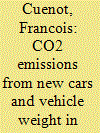| Srl | Item |
| 1 |
ID:
091529


|
|
|
|
|
| Publication |
2009.
|
| Summary/Abstract |
A segment- and fuel-disaggregated analysis of the production data of the new European vehicle market during the last decade helps to understand the sharp increase in average weight, and to introduce an indicator linking CO2 emissions to a vehicle's unit of weight. Using this indicator, simulations are made to calculate the average CO2 emissions if the average weight had stayed constant from 1995 to 2005. If the weight had remained constant, the 2008 target of 1998s voluntary agreement (VA) would have been met, and the recently approved regulation would probably have been unnecessary. Then, CO2 emissions are projected to 2015 using different vehicle characteristics and market penetration. Five scenarios have been introduced to study the different opportunities that could arise by 2015, including a backcasting scenario showing what is needed to reach the goal set by the recently approved EU climate package regulations. The analysis concludes that powertrain technologies alone are unlikely to bring the sufficient break in trends to reach set targets. Acting on average weight, through unitary vehicle weight or segment shifting, of new vehicles is key in reducing the average CO2 emissions in the short and medium term.
|
|
|
|
|
|
|
|
|
|
|
|
|
|
|
|
| 2 |
ID:
091525


|
|
|
|
|
| Publication |
2009.
|
| Summary/Abstract |
By the end of 2006, there were about 24 million total passenger cars on the roads in China, nearly three times as many as in 2001. To slow the increase in energy consumption by these cars, China began implementing passenger car fuel economy standards in two phases beginning in 2005. Phase 1 fuel consumption limits resulted in a sales-weighted new passenger car average fuel consumption decrease of about 11%, from just over 9 l/100 km to approximately 8 l/100 km, from 2002 to 2006. However, we project that upon completion of Phase 2 limits in 2009, the average fuel consumption of new passenger cars in China may drop only by an additional 1%, to approximately 7.9 l/100 km. This is due to the fact that a majority of cars sold in 2006 already meets the stricter second phase fuel consumption limits. Simultaneously, other trends in the Chinese vehicle market, including increases in average curb weight and increases in standards-exempt imported vehicles, threaten to offset the efficiency gains achieved from 2002 to 2006. It is clear that additional efforts and policies beyond Phase 2 fuel consumption limits are required to slow and, ultimately, reverse the trend of rapidly rising energy consumption and greenhouse gases from China's transportation sector.
|
|
|
|
|
|
|
|
|
|
|
|
|
|
|
|